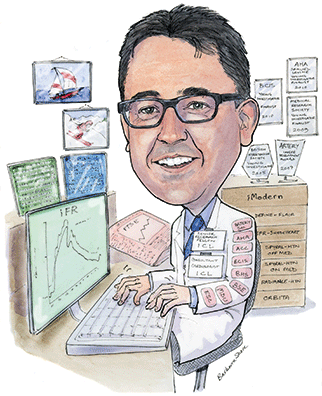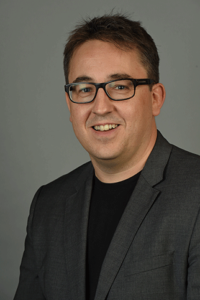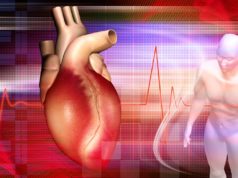
Justin Davies (Imperial College London, London, UK) has always been interested in computer programming and science and has combined these two passions in his medical career. Being able to write software—in particular, software for analysing data—led him to develop instantaneous wave-free ratio (iFR); a system that is now used to determine the severity of coronary lesions in thousands of catheter laboratories across the world. He talks to Cardiovascular News about the benefits of being fluent in software when working in the field of interventional cardiology.
Why did you decide to go into medicine and why, in particular, interventional cardiology?
I have always been interested in science and, from a very early age, I was interested in computers; I was also interested in how it was possible to use computers to interact and alter the physical world. So, these interests led me to medicine.
For me, interventional cardiology was not only a very dynamic speciality but it was also one that interfaced well with computers; you have a lot of images and data in interventional cardiology that you can use to predict and calculate information. Therefore, as it combined both science and computers, it was a natural field for me to go into.
How has your interest in computers helped you in your career?
Being able to write software and code for data analysis helped me to develop iFR, which has now been commercialised and is used in catheter laboratories around the world. If you can do your own analysis, you have got a real advantage in terms of being able to discover new things rather than just rely on what is already available.
Who have been your career mentors?
Darrel Francis (Imperial College London, London, UK) has definitely been a mentor in terms of analysing and scrutinising data. There is also Jan Piek (Department of Cardiology, Academic Medical Centre, Amsterdam, The Netherlands) and Morton Kern (Department of Medicine, Veterans Administration Long Beach Health Care System, Long Beach, USA) both of whom I have learnt much from about coronary physiology.
What has been the most important advance in interventional cardiology during your career and what has been the biggest disappointment?
Probably, transcatheter aortic valve implantation (TAVI) has been the most important advance. In terms of the biggest disappointment, I think it has been the bioresorbable vascular scaffold (Absorb, Abbott Vascular). I believe it really had the potential change the way we did things but, in its current state, it is not ready for prime time. We need to go back to the drawing board to make them more compatible for a wider range of patients than they are currently.
I do not think using the “PSP” (which involves predilatation, appropriate vessel sizing, and high-pressure dilatation) technique will make much of an impact in terms of improving long-term outcomes with devices. Rather than technique, the issue is more a bioresorbable scaffold is a very difficult technology to develop. When you implant a lump of plastic in someone, which essentially what Absorb is, there are many potential variables to consider. For example, the rate that it will degrade as this will depend on the patient’s metabolism.
That said, the concept itself is good and further iterations of the design may improve things. However, current generation of drug-eluting stents are very good and are very cost-effective. Therefore, they represent a major barrier to new technology becoming the gold standard. I do think there are some very interesting technologies out there, such as the Arterius biodegradable stent, which uses a radically different manufacturing process to overcome some of the limitations.
You have been involved with the development of iFR. How does it work and how does it compare with fractional flow reserve (FFR)
Essentially, it uses software algorithms—taking data obtained via a conventional pressure wire—to assess the severity of stenosis to determine whether or not patient requires a stent. The main difference between iFR and FFR is that you do not give a drug such as adenosine.
The recent DEFINE-FLAIR [of which, Davies was the lead investigator] and iFR-SWEDEHEART studies showed that iFR was non-inferior to FFR in terms of the major adverse cardiac events (MACE). They also both showed that procedure-related adverse events were significantly worse with FFR than with iFR. Furthermore, iFR was found to be much comfortable for the patient and also cheaper to perform.
Overall, with these studies, we have increased the physiology data four fold. The first FFR study—DEFER—only had 90 patients in the physiology arm. Furthermore, the event rate in DEFER was double that of the rates in DEFINE-FLAIR/iFR-SWEDEHEART. So, things really have moved on in the care we give to patients overall.
You were also involved in the recent SPYRAL-HTN OFF MED study. Do you think the results from this study signal a rebirth of renal denervation?
This study clearly showed that this a significant drop in blood pressure with renal denervation—which is definitely a substantial spark to fuel the flames of renal denervation development. Also, in the control arm of that study, blood pressure only dropped by ~1mmHg. In SYMPLICITY-HTN, blood pressure dropped by ~15mmHg. This was a remarkable finding because the blood pressure in the sham arm was bigger than that of the treatment arm of SPYRAL-HTN OFF MED study. Clearly this shows a major problem with HTN-3 which we now recognise as issues with patient compliance of drug therapies. I think the trial design of SPYRAL-HTN OFF MED was better than that of SYMPLICITY-HTN as the variability and bias have largely been removed.
There are number of studies that are due to come out this year, such as SPYRAL HTN-ON MED and the RADIANCE-HTN study (exploring Recor Medical’s renal denervation device). Therefore, I think renal denervation does have a future.
 Given that you were one of the investigators of the ORBITA study, what impact do you think that this study will have on the use of PCI in patients with stable angina?
Given that you were one of the investigators of the ORBITA study, what impact do you think that this study will have on the use of PCI in patients with stable angina?
ORBITA was a study conducted at Imperial College by Rasha Al-Lamee, in which I was senior author alongside Darrel Francis. This randomised controlled study explored the effect of PCI in single vessel disease in comparisons to pharmacological therapy. Importantly, both groups had the same invasive procedure, with the omission of stent deployment in the sham group. The studies clearly show a bigger, and highly significant increase in exercise time in the PCI group, which was not observed in the treatment group. But, when comparison was made between the groups using the pre-specified endpoint, no significant increase in time was detected. This raised alarm bells about the efficacy of PCI, particularly, and most strongly by the medical therapy community. In my opinion, this was scaremongering. Cardiologists treat patients, not arteries. We need a range of therapies. Is it really appropriate to give a beta-blocker to a 40-year-old male patient and subject him to a life of potential impotence, when it could be avoided with PCI? Or should we be performing PCI in patients who are not capable of taking dual antiplatelet therapy (DAPT) for the required period? Time will tell how ORBITA affects practice, but certainly I think it will be the end of angiographic guidance which led to overtreatment of 30% of patients in which FFR/iFR was negative.
What are your current research interests?
There is the iModern study, which is reviewing the role of iFR in determining the severity (and thus need for treatment) in patients undergoing primary percutaneous coronary intervention (PCI).
Data interpretation is a field that continues to grow and is one that is extremely exciting to be involved with.
We are lucky to be at a turning point in history; we now have sufficient and significant computer power to be able—very cheaply—to perform analysis to guide therapy in a way that we have never been able to before.
What has been your most memorable case and why?
A recent coronary that was quite complicated from an angiographic perspective. Three or four years ago, we would have ended up putting a series of stents into the patient but we were able to put only one stent in. Much of this simplification is possible because of the co-registration we now have between angiography and iFR.
The result was fantastic and transformed the patient’s life—we increased their blood flow with minimal angioplasty.
What advice would you give to people just coming into the profession?
Always ask the question “Why?” “Why should you do something?” “Why is this correct”, and “Why do we do the things we do?” You should never just accept that this is way that something should be done.
Also, build collaborations. They are exciting, and open a world of opportunities to young researchers and clinical around the world. It has been a real privilege and honour getting to know and making friends with, colleagues all around the world.
What was your childhood dream job?
I have always been fascinated by financial markets and still am!
Outside of medicine, what are you hobbies and interests?
Music, skiing and sailing. They are my main hobbies. I was a music scholar at Rugby school, and enjoyed playing the flute and piano throughout my school and university days. Now I enjoy skiing when I can, although time is a little more limited.
Current appointment
2012–present: Senior research fellow and Consultant Cardiologist, Imperial College London
Past appointments
- 2006–09: Specialist registrar in Cardiology, St Mary’s Hospital and Hemel Hempstead Hospital (UK)
- 2003–06: British Heart Foundation, junior research fellow, International Centre for Circulatory Health, St Mary’s Hospital & Imperial College, London, UK
- 2002–03: Senior house officer medical rotation, St Bartholomew and The Royal London Hospital, London, UK
- 2000–01: Senior house officer (Cardiology) and house officer rotation, St Mary’s Hospital, Paddington, London, UK
Degrees
- 1997: BSc (hons) Imperial College London, UK
- 2000: MBBS (hons) Imperial College London, UK
- 2003: MRCP, London, UK
- 2009: PhD Imperial College London, London, UK
- 2012: CCT Cardiology London Deanery
Prizes and awards
- 2010: AHA Samuel Levine Young Investigator prize finalist
- 2010: BCIS Young Investigator prize finalist
- 2009: Medical Research Society Young Investigator prize finalise
- 2008: British Hypertension Society Young Investigator Award (winner)
- 2007: Career development award (winner)
Professional affiliations
- Artery Society
- American Heart Association
- American College of Cardiology
- BCIS
- British Hypertension Society
- British Society of Echocardiography
- Medical Defence Union
- European Society of Cardiology
Computer skills
- Fluent in writing software in Matlab, Labview and Basic
- Installing and maintaining Microsoft Windows NT/2000 Server based networks and websites for two businesses










